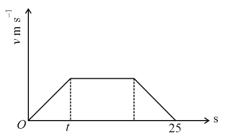Motion with Constant Acceleration
Motion with Constant Acceleration: Overview
This topic covers concepts, such as, Uniformly Accelerated Motion, Sign Convention in Accelerated Motion, Reaction Time Calculation under Constant Acceleration & Observer and Escalator Problems etc.
Important Questions on Motion with Constant Acceleration
The figure shows the graph of a particle moving in a straight line. Starting from rest, the time after which the particle returns to its starting position is

The velocity-time graph of the particle moving along a straight line is shown. The rate of acceleration and deceleration is constant and it is equal to . If average velocity during the motion is , then find the value of

An object moving with uniform acceleration has a velocity of in the positive direction when its coordinate is . If its coordinates later is , what is its acceleration?
At a distance from the traffic light brakes are applied to a locomotive moving at a velocity . Determine the position of the locomotive relative to the traffic light minute after the application of the brakes if its acceleration is .
A body starts from rest, what is the ratio of the distances traveled by the body during the 4th and 3rd seconds?
A body dropped from top of a tower falls 40 m during the last two seconds of its fall. The height of tower is
A boy standing at the top of a tower of 20 m height drops a stone. Assuming the velocity with which it hits the ground is
A particle moves a distance x in time t according to equation The acceleration of particle is proportional to:
A particle has initial velocity and has acceleration Its speed after 10 s is:
A ball is dropped from a high rise platform at, starting from rest. After another ball is thrown downwards from the same platform with the speed . The two balls meet at, . What is the value of ? (Take, )
What will be the ratio of the distances moved by a freely falling body from rest in fourth and fifth seconds of the journey?
The position of a particle with respect to time along -axis is given by, where, is in meters and is in seconds. What will be the position of this particle when it achieves maximum speed along the direction?
Two bodies, (of mass ) and (of mass ), are dropped from heights of and , respectively. The ratio of the times taken by them to reach the ground is
A ball is thrown vertically upwards. It has a speed of when it has reached one half of its maximum height. How high does the ball rise?
(Take, )
The displacement of a particle varies with time as , where , , are positive constants. The velocity of the particle will
A man throws balls with the same speed vertically upwards one after the other at an interval of 2 seconds. What should be the speed of the throw, so that more than two balls are in the air at any time?
If a ball is thrown vertically upwards with speed u, the distance covered during the last t seconds of its ascent is
A stone is thrown vertically upwards with kinetic energy K. The kinetic energy at the highest point is
The displacement of a particle is represented by the following equation : where s is in metres and t is seconds. The acceleration of the particle at is
A car moving with a speed of can be stopped by applying brakes at least after . If the same car is moving with a speed of , what is the minimum stopping distance?
